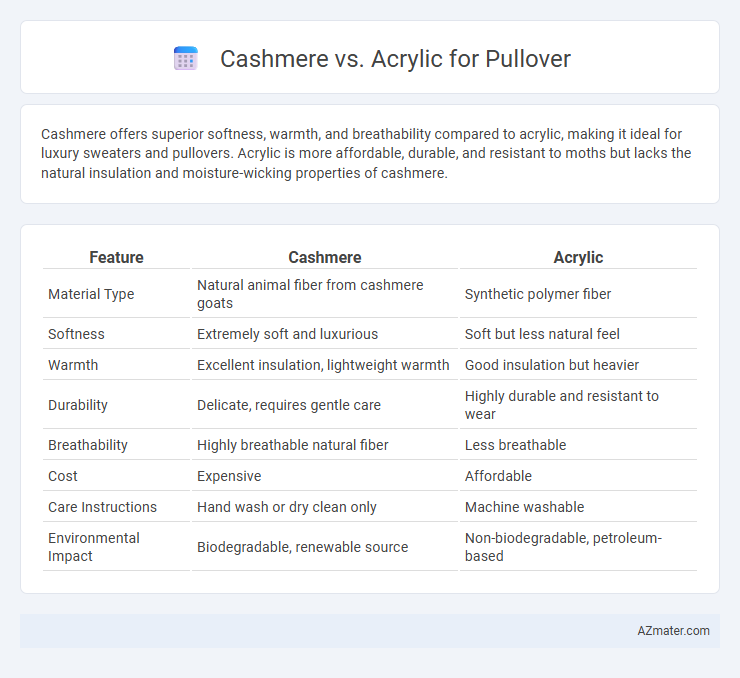Cashmere offers superior softness, warmth, and breathability compared to acrylic, making it ideal for luxury sweaters and pullovers. Acrylic is more affordable, durable, and resistant to moths but lacks the natural insulation and moisture-wicking properties of cashmere.
Table of Comparison
| Feature | Cashmere | Acrylic |
|---|---|---|
| Material Type | Natural animal fiber from cashmere goats | Synthetic polymer fiber |
| Softness | Extremely soft and luxurious | Soft but less natural feel |
| Warmth | Excellent insulation, lightweight warmth | Good insulation but heavier |
| Durability | Delicate, requires gentle care | Highly durable and resistant to wear |
| Breathability | Highly breathable natural fiber | Less breathable |
| Cost | Expensive | Affordable |
| Care Instructions | Hand wash or dry clean only | Machine washable |
| Environmental Impact | Biodegradable, renewable source | Non-biodegradable, petroleum-based |
Introduction to Cashmere and Acrylic Pullovers
Cashmere pullovers are crafted from the soft undercoat of cashmere goats, offering exceptional warmth, breathability, and lightweight comfort ideal for luxury winter wear. Acrylic pullovers, made from synthetic fibers, provide affordability, durability, and easy care, making them a popular choice for everyday casual wear. Both materials vary significantly in texture, insulation, and price, influencing their suitability for different climates and fashion preferences.
Material Overview: What is Cashmere?
Cashmere is a luxury fiber obtained from the undercoat of Cashmere goats, known for its exceptional softness, warmth, and lightweight properties compared to traditional wool. It features fine, delicate fibers that provide superior insulation and a smooth texture, making it highly sought after for premium pullovers and sweaters. Renowned for its breathability and moisture-wicking abilities, Cashmere offers comfort in both cold and mild climates.
Material Overview: What is Acrylic?
Acrylic is a synthetic fiber made from polymer compounds that mimic the softness and warmth of natural wool but at a lower cost. It offers excellent durability, moisture-wicking properties, and resistance to moths and mildew, making it a practical choice for pullovers. Unlike cashmere, acrylic is less breathable and lacks the luxurious softness and natural insulating qualities that cashmere fibers provide.
Softness and Comfort Comparison
Cashmere pullovers offer superior softness and luxurious comfort due to their fine, natural fibers that provide excellent warmth without weight. Acrylic pullovers, while more affordable and durable, tend to feel less soft and can sometimes cause irritation for sensitive skin. Choosing cashmere ensures enhanced breathability and a plush texture, making it ideal for those prioritizing comfort in cold weather.
Warmth and Insulation
Cashmere offers superior warmth and insulation compared to acrylic due to its natural fine fibers that trap heat effectively while remaining lightweight. Acrylic, a synthetic fiber, provides moderate insulation but lacks the moisture-wicking properties and breathability of cashmere. For cold weather pullovers, cashmere delivers enhanced thermal regulation and comfort, making it a premium choice over acrylic blends.
Durability and Longevity
Cashmere pullovers provide softness and luxury but are less durable, prone to pilling and wear over time compared to acrylic. Acrylic fabric is highly durable, resistant to abrasion, and maintains shape and color even after multiple washes, making it more suitable for long-term use. For longevity, acrylic outperforms cashmere in retaining appearance and structural integrity under regular wear conditions.
Cost and Affordability
Cashmere pullovers typically carry a higher price tag due to the luxury fiber's rarity and softness, often ranging from $150 to $500 or more. Acrylic pullovers offer a budget-friendly alternative, commonly priced between $20 and $60, providing affordability without sacrificing durability. Consumers seeking premium warmth invest in cashmere, while those prioritizing cost-effectiveness opt for acrylic garments.
Care and Maintenance Requirements
Cashmere requires gentle hand washing or dry cleaning with a mild detergent to maintain its softness and prevent damage, while acrylic can be machine washed on a gentle cycle and is more resistant to shrinking and stretching. Cashmere fibers are delicate and prone to pilling, so it is essential to avoid exposure to high heat and friction during wear and cleaning. Acrylic pullovers offer easier maintenance and durability, making them a practical choice for everyday use with less stringent care demands.
Eco-Friendliness and Sustainability
Cashmere pullovers, derived from the undercoat of cashmere goats, offer natural biodegradability and renewable fiber sources, promoting eco-friendliness when sourced responsibly. Acrylic pullovers, made from petroleum-based synthetic fibers, contribute to plastic pollution and lack biodegradability, raising sustainability concerns. Choosing sustainably farmed cashmere with certifications like the Sustainable Fibre Alliance supports ethical production and reduces environmental impact compared to conventional acrylic alternatives.
Which Pullover Material is Right for You?
Cashmere pullovers offer exceptional softness, natural insulation, and breathability, making them ideal for those seeking premium warmth and luxury despite a higher price point. Acrylic pullovers provide a more affordable, durable, and easy-care alternative with good insulation but lack the natural fibers' breathability and softness. Choosing between cashmere and acrylic depends on budget, sensitivity to fabric, and desired durability for everyday wear.

Infographic: Cashmere vs Acrylic for Pullover
 azmater.com
azmater.com